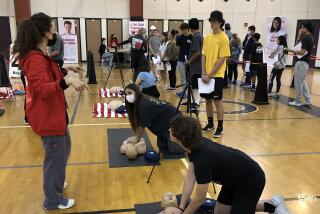The Initial Results: AED Is a Lifesaver
- Share via
It was the kind of rescue attempt you don’t forget, said Capt. Marty Kasules of the Sheriff’s Harbor Patrol:
A sailboat, at full sail, was cutting the water in circles in Newport Harbor. The skipper had collapsed in the boat’s cockpit; a frantic non-sailor aboard was seeking help. The victim was revived twice by cardiopulmonary resuscitation, but died en route to the hospital.
It got Kasules thinking: Could the sailor have been saved if the harbor patrol boats had been carrying AEDs?
That’s not a household acronym yet, like CPR. But it may be someday. Some police agencies--such as the Placentia and La Habra police here in Orange County--have begun to carry them routinely in patrol cars. The airlines are going after them too. A recent White House study showed that the AED could save 20,000 lives a year just on federal property.
This week, all sheriff’s patrol fireboats in the county’s three harbors began carrying the device.
The AED--automatic external defibrillator--is a new lifesaving device that’s growing in popularity with police agencies and fire departments. Built like a small briefcase, it’s a portable medical device with adhesive electrode pads that attach to a victim. It can analyze heart rhythm and administer a shock to restart a heart rhythm in cases where the victim’s abnormal rhythm (ventricular fibrillation, hence the name) can be detected. The captain said the AED will even tell when you should not use the shock device.
Three of Kasules’ deputies have taken special training in the use of AEDs as well as training in how to teach other deputies how to use them. All Harbor Patrol deputies are qualified to administer AEDs.
Kasules predicts they will save lives. He’s seen scores of rescues over the years where a victim lost consciousness from a near-drowning or collapsed from overexertion.
“A lot of people go out on fishing boats and don’t realize how much work they’re doing,” he said.
Deputy Jim Slikker , one of three specialists in the AED, said it can save time that CPR can’t.
“Every minute that goes by after a collapse, the chances of losing the victim go up 10%,” Slikker said. “Sometimes we’re out on a boat 10 to 15 minutes before paramedics can take over.”
If you aren’t familiar with the sheriff’s Harbor Patrol, it’s the only 24-hour watchdog the county has in its three harbors and along its 42 miles of beach (extending three miles out to sea). Last year it investigated 124 boating accidents and completed 138 boating rescues. More than 50 of those involved medical assistance. And here’s the key factor: 12 involved someone suffering cardiac arrest.
Medical experts the Harbor Patrol has talked with about AEDs say that cardiac arrest victims can be treated successfully 60% of the time if external defibrillation is administered within four minutes. AEDs are put to use when three conditions occur: The victim is unconscious, has no visible pulse and isn’t breathing. Kasules emphasized that the AEDs do not replace CPR; the device is used in conjunction with CPR. Without AED, Kasules points out, CPR can only sustain a victim until paramedics arrive.
The AED is lightweight but durable. The Sheriff’s Department bought 10 of the devices for its fireboats but also has them at its harbor sites for land rescues. Kasules is convinced the AEDs will also wind up being used on land--either on the beaches or in some of the beach-side shops.
“It’s just one more tool that can save a life,” Kasules said.
*
Readers may reach Hicks by calling (714) 966-7789 or by e-mail to jerry.hicks@latimes.com
More to Read
Sign up for Essential California
The most important California stories and recommendations in your inbox every morning.
You may occasionally receive promotional content from the Los Angeles Times.













